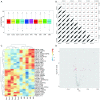Discovery of potential plasma protein biomarkers for acute myocardial infarction via proteomics
- PMID: 31656670
- PMCID: PMC6790472
- DOI: 10.21037/jtd.2019.08.100
Discovery of potential plasma protein biomarkers for acute myocardial infarction via proteomics
Abstract
Background: Acute myocardial infarction (AMI) is an acute disease with high mortality and seriously threatens human health. The identification of new effective biological markers for AMI is a prerequisite for treatment. Most proteomic studies have focused on atherosclerotic plaques, vascular cells, monocytes and platelets in the blood; however, the concentration of these factors in plasma is low, making it difficult to measure the complexity of plasma components. Moreover, some studies have examined the plasma protein of patients with acute coronary syndrome with histochemistry; however, the results are not consistent. Therefore, it is necessary to further investigate the differential proteins in the plasma of patients with AMI via proteomics to identify new biomarkers of AMI.
Methods: In this study, immunodepletion of high-abundance plasma proteins followed by an isobaric tagging for relative and absolute quantitation (iTRAQ)-based quantitative proteomic approach was used to analyze plasma samples from 5 control individuals and 10 AMI patients.
Results: Four hundred sixty-eight proteins were identified from two samples, and 33 proteins were differentially expressed in AMI patients compared to the controls. Among the 33 proteins, 12 proteins showed a ≥1.5-fold change between AMI and control samples. These proteins included fatty acid binding protein 3 (FABP3, ratio =6.36), creatine kinase-MB (CK-MB ratio =4.89), adenylate kinase1 (AK1 ratio =4.16), pro-platelet basic protein (PPBP ratio =3.29), creatine kinase (CK ratio =2.88), platelet factor 4 (PF4 ratio =2.62), peptidyl prolyl isomerase Cyclophilin A (PPIA ratio =2.05), Cofilin-1 (CFL1 ratio =1.81), coronin1A (CORO1A ratio =1.71), protein kinase M (PKM ratio =1.63), ribonuclease inhibitor (RNH1, ratio =1.67), and triose phosphate isomerase (TPI1 ratio =1.56). By contrast, there was a decrease of 19 proteins, such as adiponectin (ADIPOQ ratio =0.70), insulin-like growth factor binding protein6 (IGFBP6 ratio =0.70), Dickkopf-related protein 3 (DKK3 ratio =0.70) and complement 4B (C4B ratio =0.68). The most over-represented term was regulation of cell proliferation in the cellular component category of Gene Ontology (GO). The top 3 biological process terms were regulation of cell proliferation, response to wounding and wound healing. These proteins included immune proteins, blood coagulation proteins, lipid metabolism proteins, cytoskeleton proteins, energy metabolism proteins, gene regulation proteins, myocutaneous proteins, and myocardial remodeling proteins and were highly connected with each other, which indicates that the functional network of these processes contribute to the pathophysiology of AMI.
Conclusions: In conclusion, the present quantitative proteomic study identified novel AMI biomarker candidates and might provide fundamental information for the development of an AMI biomarker.
Keywords: Plasma protein biomarkers; acute myocardial infarction (AMI); proteomics.
2019 Journal of Thoracic Disease. All rights reserved.
Conflict of interest statement
Conflicts of Interest: The authors have no conflicts of interest to declare.
Figures


Similar articles
-
Identification of novel candidate biomarkers for acute myocardial infarction by the Olink proteomics platform.Clin Chim Acta. 2023 Aug 1;548:117506. doi: 10.1016/j.cca.2023.117506. Epub 2023 Aug 6. Clin Chim Acta. 2023. PMID: 37549822
-
Characterization of differentially expressed plasma proteins in patients with acute myocardial infarction.J Proteomics. 2020 Sep 15;227:103923. doi: 10.1016/j.jprot.2020.103923. Epub 2020 Jul 28. J Proteomics. 2020. PMID: 32736138
-
Isobaric tags for relative and absolute quantitation‑based proteomics reveals potential novel biomarkers for the early diagnosis of acute myocardial infarction within 3 h.Int J Mol Med. 2019 May;43(5):1991-2004. doi: 10.3892/ijmm.2019.4137. Epub 2019 Mar 19. Int J Mol Med. 2019. PMID: 30896787 Free PMC article.
-
Cardiac markers in the early hours of acute myocardial infarction: clinical performance of creatine kinase, creatine kinase MB isoenzyme (activity and mass concentration), creatine kinase MM and MB subform ratios, myoglobin and cardiac troponin T.Scand J Clin Lab Invest. 1996 Dec;56(8):701-13. doi: 10.3109/00365519609088817. Scand J Clin Lab Invest. 1996. PMID: 9034351
-
Serum markers in the emergency department diagnosis of acute myocardial infarction.Emerg Med Clin North Am. 2001 May;19(2):321-37. doi: 10.1016/s0733-8627(05)70186-3. Emerg Med Clin North Am. 2001. PMID: 11373981 Review.
Cited by
-
Quantitative Analysis of the Seminal Plasma Proteome in Secondary Hypogonadism.J Clin Med. 2019 Dec 3;8(12):2128. doi: 10.3390/jcm8122128. J Clin Med. 2019. PMID: 31816910 Free PMC article.
-
Dl-3-n-butylphthalide attenuates myocardial ischemia reperfusion injury by suppressing oxidative stress and regulating cardiac mitophagy via the PINK1/Parkin pathway in rats.J Thorac Dis. 2022 May;14(5):1651-1662. doi: 10.21037/jtd-22-585. J Thorac Dis. 2022. PMID: 35693588 Free PMC article.
-
Various Expressions of PIK3C2A and TXNIP Genes and Their Potential Role as Independent Risk Factors for Chronic Stable Angina and Acute Coronary Syndrome.Biomolecules. 2023 Feb 6;13(2):302. doi: 10.3390/biom13020302. Biomolecules. 2023. PMID: 36830671 Free PMC article.
-
Correlation between serum cyclophilin A and acute ST-segment elevation myocardial infarction and its predictive value.Front Cardiovasc Med. 2025 May 27;12:1566129. doi: 10.3389/fcvm.2025.1566129. eCollection 2025. Front Cardiovasc Med. 2025. PMID: 40495988 Free PMC article.
-
The FLNA Gene in Tumour-Educated Platelets Can Be Utilised to Identify High-Risk Populations for NSCLCs.J Cell Mol Med. 2025 Apr;29(7):e70544. doi: 10.1111/jcmm.70544. J Cell Mol Med. 2025. PMID: 40208200 Free PMC article.
References
LinkOut - more resources
Full Text Sources
Research Materials
Miscellaneous
